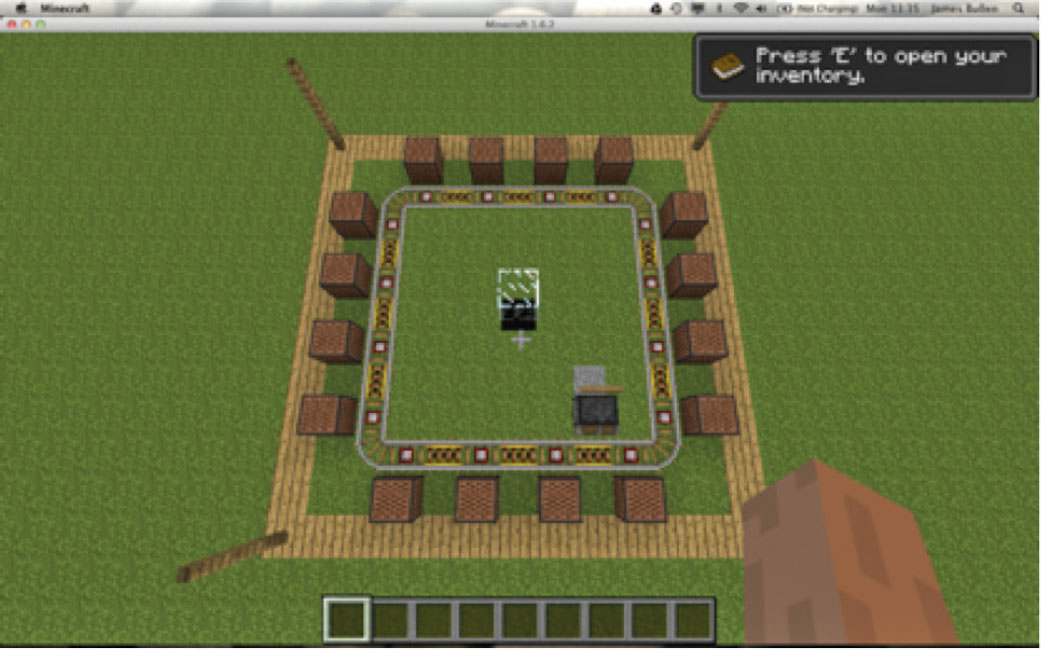
It was a discussion with pupils from my Saturday morning music technology class that first tipped me off to the potential for Minecraft as a platform for musical learning. As avid Minecraft players, they regularly talked about the game in class with each other and when they mentioned that they had been making music in Minecraft, my ears pricked up. They gave me a few tips about how to get started and pointed me in the direction of some YouTube videos of extraordinary musical constructions made in Minecraft.
At first I was surprised and impressed as I had severely underestimated the breadth and depth of creative possibilities available in a game that, on first glance, appeared to be quite primitive. I was naive, and my students quickly became my teachers. They showed me that not only could you create blocks that make pitched sounds, you could also arrange these blocks into vast, elaborate structures that were, not unlike an old pianola or music box, capable of playing entire songs with polyphonic parts and multiple timbres. I was fascinated by what they were showing me and it inspired me to experiment with Minecraft myself.
After downloading a copy of the game to my laptop, I enlisted the help of my nine-year-old nephew and started exploring. The first thing I learned is that Minecraft is a bit like Lego (I know, I was really out-of-the-loop!) in that players exist in a world of building blocks. Most of these blocks are fairly simple in that they represent real-world materials, such as stone or wood, but the ones I was most interested in were the ones that interact with ‘redstone’, a game concept that functions like electricity. Redstone can be used for a range of purposes, but I was most interested in seeing how it could be used to trigger sounds from note blocks, which in turn could be set to play any particular note you like. Armed with this knowledge, I set about trying to build redstone machines that would use note blocks and redstone to make music.
Making sense of it all
Many hours of head-scratching, watching YouTube tutorial videos, and reading online Minecraft forums later, I managed to build a piano roll that could be programmed to play any eight-bar piece of music. I programmed it to play the melody and chords from the first eight bars of ‘Fly Me to the Moon’, which sounded a little odd but was at least recognisable. The result of my experiment wasn't quite as sophisticated as some of the contraptions my Saturday school pupils had showed me on YouTube, but it did get me thinking about whether I could use Minecraft with my music classes at school.
I discovered that there are an increasing number of schools and colleges around the world that are using MinecraftEdu: teachers can use this to host classes, and it has already been used successfully to teach various concepts in science, geography and English. With MinecraftEdu, and a bit of help from my school's IT team, I undertook a small-scale study into whether Minecraft could be a useful teaching tool in the music classroom for a whole class of Year 9 students.
First, I created a Minecraft world for the students to work in that would serve as our classroom, preparing constructions that could be used to sequence short musical ostinatos. This removed the need for pupils, particularly those who hadn't played the game before, to build anything during the lesson, as well as providing a closed system with exactly the resources required for the lesson in hand.
These constructions consisted of 16-note blocks surrounding a looping track. The students could then trigger the notes to play in sequence by placing a ‘mine cart’ on the track and setting it into motion. As the mine cart passes each note block it triggers a sound. I also gave students cheat sheets which showed them how many clicks were required to set the note blocks to play certain notes. The sheet also listed a few tunes for pupils to sequence which included a walking bassline, the main theme from Mike Oldfield's ‘Tubular Bells’, the beginning of Beethoven's ‘Für Elise’, and a few others.
Help or hindrance?

Pupils can use a musical track in Minecraft as a starting point
All 27 students in the class were able to complete at least one of the listed tunes on the handout by the end of the session and at least one example of each tune was performed by the students. Many pupils also engaged in a more original approach to their work, creating some interesting ostinatos that were not dissimilar in sound to serialism, but still pleasing nonetheless!
Although pupils enjoyed the lesson some found the process fiddly, and I would argue that the balance between challenge and musical satisfaction wasn't really aided by using Minecraft but ather hindered somewhat. In conclusion, although Minecraft can be a fun way to explore music in schools, it would need some tweaks and changes made to the game to make it really useful for music teachers on a regular basis.
Hopefully in the future, a modified version of the game can be made with music teachers in mind. Until then, Minecraft remains an enjoyable but awkward way of making music with classes.
If you are interested in trying a project like this yourself and would like to know more about how to do it, please contact me on Twitter – @jamesbullen1990




